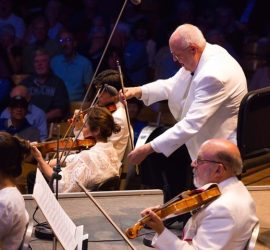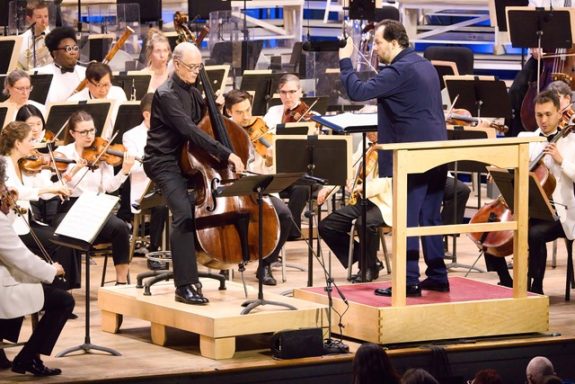 United States Tanglewood Festival 2024 [6]: Soloists, Boston Symphony Orchestra / Andris Nelsons (conductor). Koussevitzky Shed, Lenox. (RP)
United States Tanglewood Festival 2024 [6]: Soloists, Boston Symphony Orchestra / Andris Nelsons (conductor). Koussevitzky Shed, Lenox. (RP)

‘But for Koussevitzky, we wouldn’t be here today’. Those words were heard repeatedly at Tanglewood over the course of a three-day celebration of the 150th anniversary of the remarkable man’s birth and the hundredth anniversary of his becoming music director of the Boston Symphony Orchestra.
The Russian-born virtuoso double bassist, composer and conductor was the BSO’s music director for 25 years from 1924 to 1949. Established in 1937, Tanglewood serves not only as the summer home of the BSO, but also as an ‘academy for living and working in music’. It may be Koussevitzky’s most tangible legacy, but not his only one.
Koussevitzky was instrumental in championing new works from the beginning of his career, first in Moscow and then in Paris. Once in Boston, however, his efforts became central to the BSO’s mission and, in 1942, he established the Koussevitzky Music Foundation. Over 500 new works have been commissioned to date.
The music performed over the course of the three-day celebration demonstrated the breadth of Koussevitzky’s musical endeavors. He was celebrated as a composer with a performance of his Concerto for Double Bass and Orchestra, which he composed and premiered as soloist in Moscow in 1905. Works representative of those commissioned under the BSO’s auspices when he was music director, or by the foundation, were also performed.
Nostalgia, however, was in short supply, as the focus was just as squarely on the present as the past. The first two concerts in the celebration (reviewed here) opened with works by Steven Mackey and Tania León, both of whom came as young artists to study at Tanglewood. They returned this year to co-direct the Tanglewood’s Festival of Contemporary Music.
Steven Mackey’s Urban Ocean, commissioned by the Aquarium of the Pacific, opened the first concert. Rather than focus solely on the sounds of the sea which have inspired so many composers, Mackey chose to capture the entire sound spectrum, both natural and human made, experienced in the Southern California coastal ecosystem.
Nelsons and the BSO brought those wonderful sonorities to life. The sounds from night clubs in the distance may have intruded into the calls of cavorting dolphins and waves crashing onto shore, but nature won out. The bubbling of waves as they gently subsided on the sand made you feel the sand between your toes.

As evidenced in his Concerto for Double Bass, Koussevitzky’s personal musical language is as eclectic as it is romantic. Passages reminiscent of Saint-Saëns, Dvořák, Tchaikovsky and Rachmaninoff coursed through the piece. The solo double bass part is replete with melody and virtuoso passages, which the BSO’s longtime principal double bassist played with a lean singing tone and untold grace, yet without a trace of sentimentality, on Koussevitzky’s own instrument.
Sibelius wrote The Origin of Fire in 1902 for the opening of the Finnish National Theater in Helsinki, and Koussevitzky led the first performances by the BSO in 1937. For The Origin of Fire, Sibelius set a text from the Kalevala, the Finnish creation epic, which depicts in music the moment when the god Ukko kindles fire for the first time.
This performance captured all the excitement of Sibelius’s dramatic, colorful musical realization of the scene. The mood was set by the low woodwinds evoking darkness and despair, which were transformed into hope as baritone Will Liverman told of Ukko’s attempts to kindle a flame. With the entry of the excellent men of the Tanglewood Festival Chorus, the piece took flight with musical sparks as bright as the first flame shooting across the night sky of which they sang.
The final work on the program was Prometheus, Scriabin’s setting of the Greek myth on the origin of fire. Koussevitzky conducted the world premiere in Moscow in 1911 and the BSO premiere in 1925. This performance, as with the earlier ones, lacked the lighting effects which Scriabin intended to accompany the music. It did, however, contain a kaleidoscope of textures, emotions and musical colors.
Pianist Yefim Bronfman was the soloist in this complex work. With little opportunity for him to display virtuosity, Bronfman was an integral part of the eclectic musical texture. Nelsons released the drama in the tale as effectively as he had in Sibelius’s setting of the Nordic version of the myth. With the entry of the entire Tanglewood Festival Chorus, the performance acquired additional tonal luster and immediacy.
The following evening’s concert opened with Tania León’s Stride for orchestra, which she composed for the New York Philharmonic in 1919 to celebrate the centenary of the passing of the Nineteenth Amendment guaranteeing women the right to vote. León evoked musical references to American music, most notably jazz, but the lasting impression of the work is the wonderful, blatant, out-of-tune trumpet fanfares which began and ended the work.
In 1941, once the USA and USSR had become allies in World War II, Koussevitzky championed works by Soviet composers in a show of unity and support for the two countries and their musicians. Arthur Fiedler, however, beat Koussevitzky to the punch by introducing Khachaturian’s Piano Concerto in D-flat to Boston audiences with the Boston Pops in 1942. Koussevitzky led the first of his many BSO performances of the concerto in the following year and recorded it commercially.
Khachaturian was born into a working-class Armenian family in Tbilisi in 1936. Well versed in the folk music of the region, Khachaturian was adept at combining those traditions with Western classical music sensibilities to create a nationalistic style that generally found favor with Soviet censors and authorities. He composed his Piano Concerto in D-flat in 1937, and it proved to be popular from the start.
Part of the concerto’s appeal is undoubtedly Khachaturian’s use of folk tunes, as well as the exotic sound of the flexatone in the second movement. A musical saw was used in this performance, and Robert Froehner’s playing of the instrument was as captivating to watch as it was to hear. Equally compelling was the playing of bass clarinetist Andrew Sandwick in the solo passages in the first movement.
The concerto is often described as being bold, brash and bombastic, and that it is. However, Nelsons instilled lyricism in the score at every opportunity. One marveled at the technical prowess and power which Jean-Yves Thibaudet brought to the relentless rhythmic propulsion and intensity of the solo piano part in this exhilarating, almost exhausting performance.
The concert concluded with Tchaikovsky’s ‘Pathétique’ Symphony. The first BSO performance was in 1894, the year after the composer’s death. Koussevitzky led the first Tanglewood performance in 1938. For the many sitting on the lawn, this piece was undoubtedly the draw.
Nelsons crafted a performance that was emotionally compelling and musically exciting. The third movement ended in triumph. Who could begrudge the applause which erupted after the final notes had sounded? But Nelsons commanded and got total stillness as the final, ever-so-soft, notes of the fourth movement vanished into the night air.
Rick Perdian
26.7.2024 – Various: Yefim Bronfman (piano), Edwin Barker (double bass), Will Liverman (baritone), Tanglewood Festival Chorus / James Burton (conductor).
Steven Mackey – Urban Ocean
Koussevitzky – Concerto for Double Bass and Orchestra, Op.3
Sibelius – The Origin of Fire for baritone, male chorus and orchestra, Op.32
Scriabin – Prometheus: The Poem of Fire, Op.60
27.7.2024 – Various: Jean-Yves Thibaudet (piano).
Tania León – Stride
Khachaturian – Piano Concerto in D-flat, Op.38
Tchaikovsky – Symphony No. 6 in B minor, Op. 74 ‘Pathétique’
